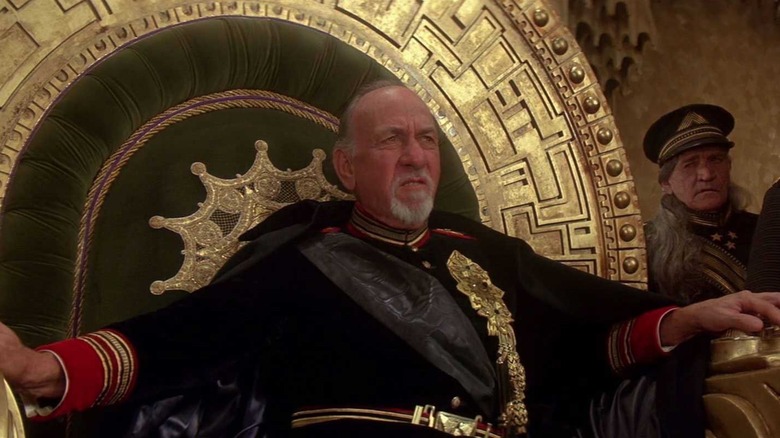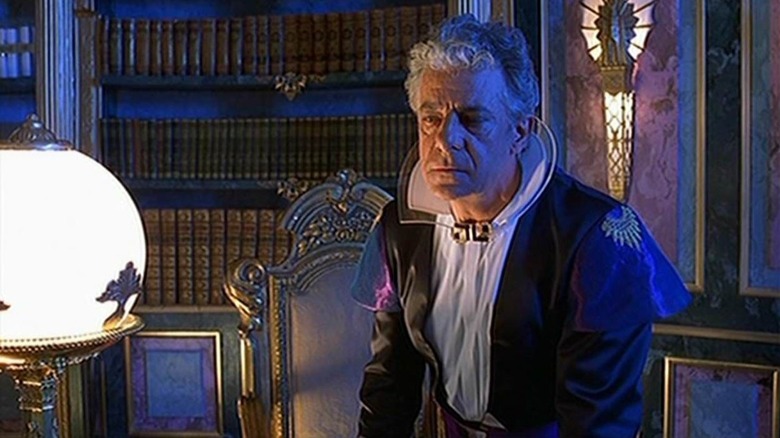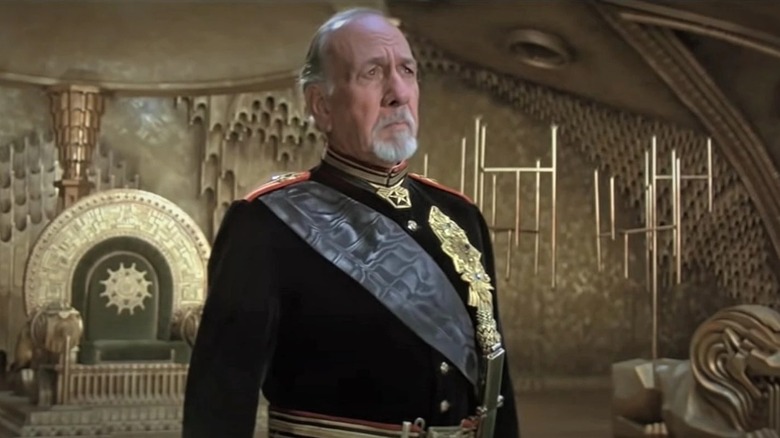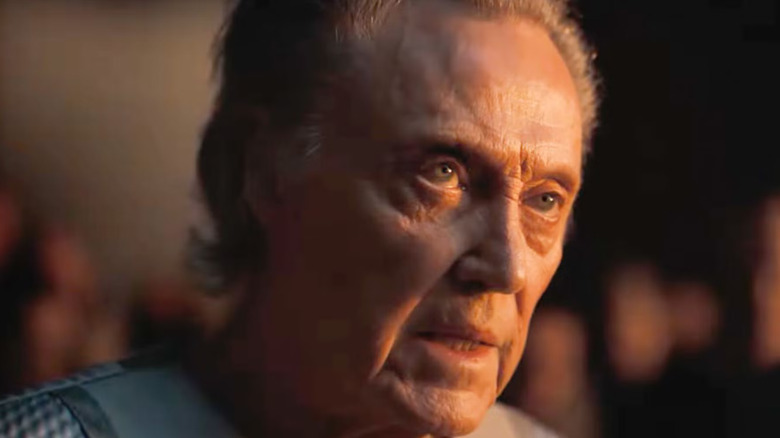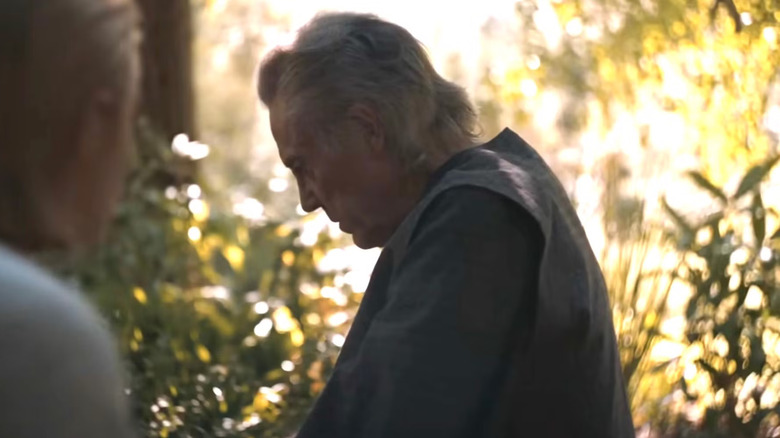Who Is Emperor Shaddam IV In Dune?
At the beginning of Frank Herbert's 1965 novel "Dune" — set in the distant, distant future — Duke Leto Atreides, the ruler of the ocean planet of Caladan, is assigned the task of overseeing the distant desert world of Arrakis by the Padishah Emperor, Shaddam IV. Arrakis is particularly valuable to the galaxy, as it is the only known source of the spice Melange, a consciousness-expanding psychedelic substance that grants humans the skills they need to travel through deep space. Arrakis had previously been overseen by House Harkonnen, a wicked and greedy clan of hedonists, and House Atreides seemingly promised a more benevolent rule and gentle hand when overseeing spice production. The Atreides and the Harkonnens have long been bitter rivals.
Of course, Shaddam IV has a scheme of his own, and only assigned House Atreides to Arrakis for reasons of treachery. It seems that Duke Leto Atreides was becoming too popular with the citizens of the galaxy, and Shaddam IV saw him as a political threat. The Emperor secretly conspired with House Harkonnen, lending them his ultra-powerful space army, as a means to assassinate the Duke and the rest of the Atreides. The Emperor, it seems, is not a very kind dude.
As fans of "Dune" know, though, the Emperor's plans will go completely pear-shaped when the Duke's son, Paul, escapes the attack and moves in with the mystical Fremen, the natives of Arakkis. The first "Dune" novel ends with Shaddam IV abdicating his throne.
Shaddam IV, while not always an active participant, is one of the key players in "Dune," and is essentially responsible for instigating all of the novel's drama. He would go on to be played by José Ferrer in David Lynch's 1984 film adaptation of "Dune," by Giancarlo Giannini in the 2000 miniseries, and by Christopher Walken in Denis Villeneuve's "Dune: Part Two." In Alejandro Jodorowsky's famously canceled "Dune" film, he was to be played by Salvador Dalí.
How Shaddam IV is described in Frank Herbert's Dune novels
Frank Herbert's novels — and some late-stage prequels — go into great detail about Shaddam IV. He belongs to House Corrino (there are many Houses in the "Dune" universe), and serves as the 81st Padishah Emperor ("Padishah" is merely the inherited title of the emperors in House Corrino, and is derived from the Persian words for "master king"). At the end of "Dune," Paul technically became the Padishah Emperor, and his son, Leto II, also eventually took it on in "Dune" sequels, but the title ceased to be when the Imperium fell.
Herbert described him as a tall, thin redhead with "cold eyes," and he was compared by some characters to a predatory bird. He regularly ingested spice, making him look a lot younger than he actually was (by the novel's gauge, he was 72 but looked 35). He appeared in the first "Dune" novel, but was presumably killed before the events of Herbert's first follow-up "Dune Messiah" (1969), and was only mentioned in the third book, "Children of Dune" (1976).
Shaddam IV also played a key role in Brian Herbert's and Kevin J. Anderson's "Prelude to Dune" prequel trilogy which included "Dune: House Atreides," (1999), "Dune: House Harkonnen" (2000), and "Dune: House Corrino" (2001). The story of the trilogy is set only a few decades before the first "Dune." In the series, Paul is about to be born, and Duke Leto Atreides is fighting against the machine planet of Ix. Shaddam IV, attempting to seize control of the galaxy's spice resources, creates a synthetic version, and begins destroying the natural stuff. Brian Herbert, incidentally, helped with the script of the 2021 "Dune" film.
Shaddam IV also appears in "Paul of Dune" (2008), which is set in between "Dune" and "Dune Messiah," and is a supporting player in the Caladan trilogy, which includes "Dune: The Duke of Caladan" (2020), "Dune: The Lady of Caladan" (2021), and "Dune: The Heir of Caladan" (2022).
Like most of the politicians in the "Dune" universe, Shaddam IV is defined by his deviousness, ambition, and complete lack of morals.
How Shaddam IV is depicted in David Lynch's Dune
In David Lynch's elaborate 1984 film adaptation of "Dune," a notorious bomb, Shaddam IV is played by José Ferrer. Lynch restaged the Emperor's plan to assassinate House Atreides as having an eerie, mystical aspect. It seems that the Spacing Guild, the spice-takers responsible for space travel, have more or less ordered Shaddam to kill Paul Atreides in particular. They have seen the future, and understand that Paul is a threat to them. The Emperor agrees to go along with their plan, making the character seem more pliable and less strong-willed than in Herbert's novel.
Shaddam is also aged up for Lynch's film, as José Ferrer was already in his early 70s when it was shot. There is a line of dialogue in the film, though, that suggests he is actually over 200 years old. Ferrer is a commanding presence, however, even if he feels more like a pawn this time. His reduced menace allowed the Baron Vladimir Harkonnen (Kenneth McMillan) to emerge as the film's true villain, and it was the Baron who got to cackle and wheeze and speak of his own powers and sexual prowess. Near the end of the film, the Emperor and the Baron are finally together in the same room, and they both seem so pathetic when compared to the newfound magical might of Paul Atreides (Kyle MacLachlan).
Lynch's film leans into the mystical aspects of Herbert's novel, even going so far as to invent new magical conceits; Paul, for instance, uses a weapon called a "weirding module," a widget that converts his voice into ultra-destructive psychic bullets. At the end of the film, he can psychically summon rain. Shaddam IV is seen as an old fossil in that he has no mystical powers.
How Shaddam IV is depicted in Denis Villeneuve's Dune movies
There was a TV mini-series in 2000 that featured Giancarlo Giannini as Shaddam IV, and he comes across, weirdly, as a wise old sage. This depiction would likely inform the 2021 rendition.
Shaddam IV doesn't appear in Denis Villeneuve's 2021 film adaptation of "Dune," but he is played by Christopher Walken in "Dune: Part 2" (2024). Villeneuve, unlike Lynch, skews very far away from the mystical aspects of the "Dune" story, depicting it entirely as a massive sociopolitical thriller with various factions attempting to wrest control of the spice from one another. Like the Ferrer depiction, the Walken version of Shaddam IV is much older, although there is no dialogue to imply that the spice is extending his life. He is also, like in the books, seen as wholly ambitious, but also wiser and more careful about protecting his throne and his legacy. Walken's age makes Shaddam IV look like he is near retirement, and wants to cement his legacy. He knows about the violence, but isn't depicted as cold or bloodthirsty.
The Ferrer and Giannini versions made the character seem measured, even if they were easily overwhelmed by Paul's Fremen forces. The Walken version actually puts on a strong visage, and one can see, if only briefly, the terrifying tyrant he must have been, once upon a time. There is so much going on in Villeneuve's two "Dune" movies, though, that Shaddam IV cannot be one of the key players in the drama. He seems like a distant supporting character, even if he was secretly instigating the action. His absence from the 2021 "Dune" made him seem academic, leaving the evil in the hands of the Harkonnens.
What does each depiction of Shaddam IV have in common?
The filmed versions of Shaddam IV all possess a strange weariness, likely because they are all older than the character in Herbert's novels. Herbert depicted the Emperor as a sinister puppet-master, trying to expertly and villainously manipulate the galaxy the same way his ancestors all did. In the films, Shaddam IV, while always up to no good, rarely emerged as a villain or a threat. He was, cinematically, the final, pathetic vestige of a crumbling galactic monarchy. He was the final roadblock to a future of Atreides rule and potential messiah-hood.
Weirdly, Shaddam IV wasn't consistently strong throughout the various adaptations. In Lynch's version, he was confident and assured. In the 2000 miniseries, he was short-tempered. In the 2024 film, he seemed tired and ready for rest. It's telling that Shaddam IV is depicted as mobile in Herbert's novels, in a throne room in Lynch's film, in an office in the miniseries, and in a garden in Villeneuve's film. These locales, more than anything, seem to dictate the tone of the character.
Shaddam IV will likely not appear in any additional Villeneuve "Dune" adaptations, as there is a years-long gap between the first and second novels, and Villeneuve would want to recreate that. He will also not appear in the TV series "Dune: Prophecy," as it is set 10,000 years before the first "Dune" novel. As of this writing, the Emperor has fallen.
